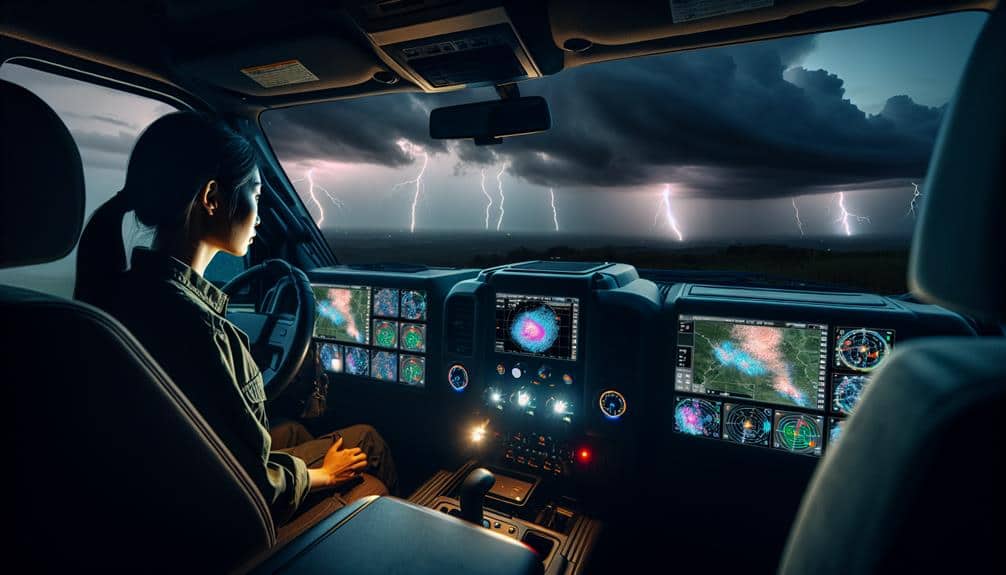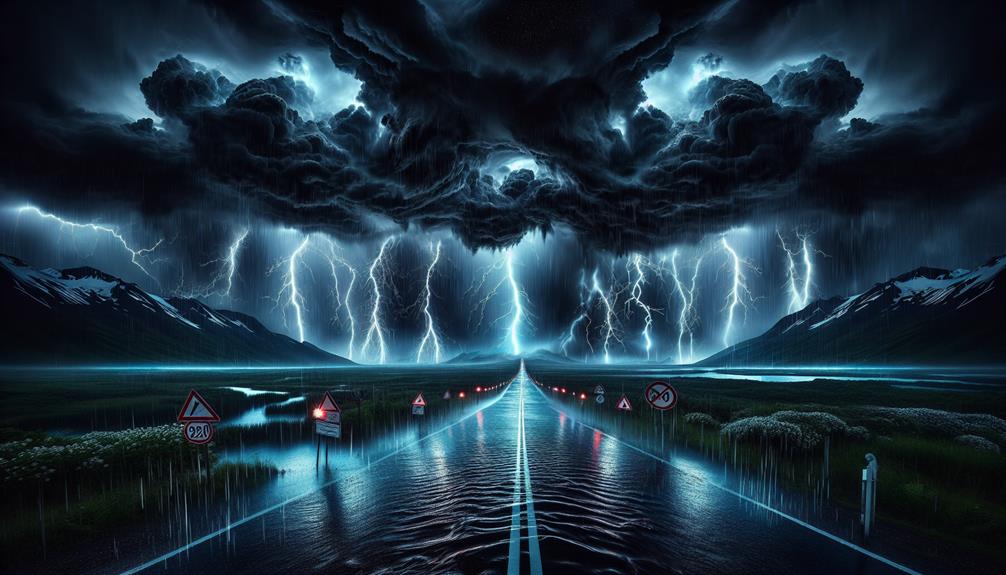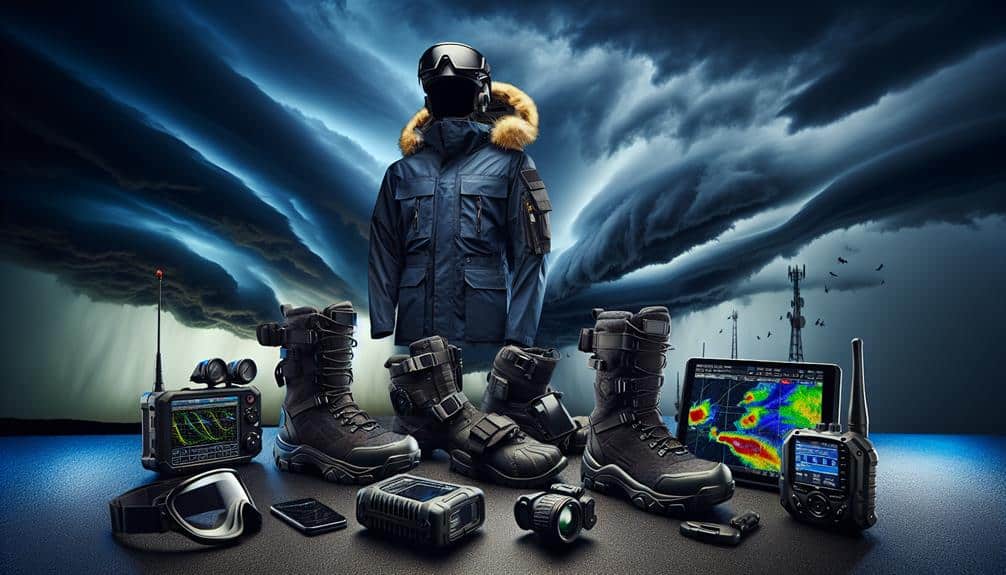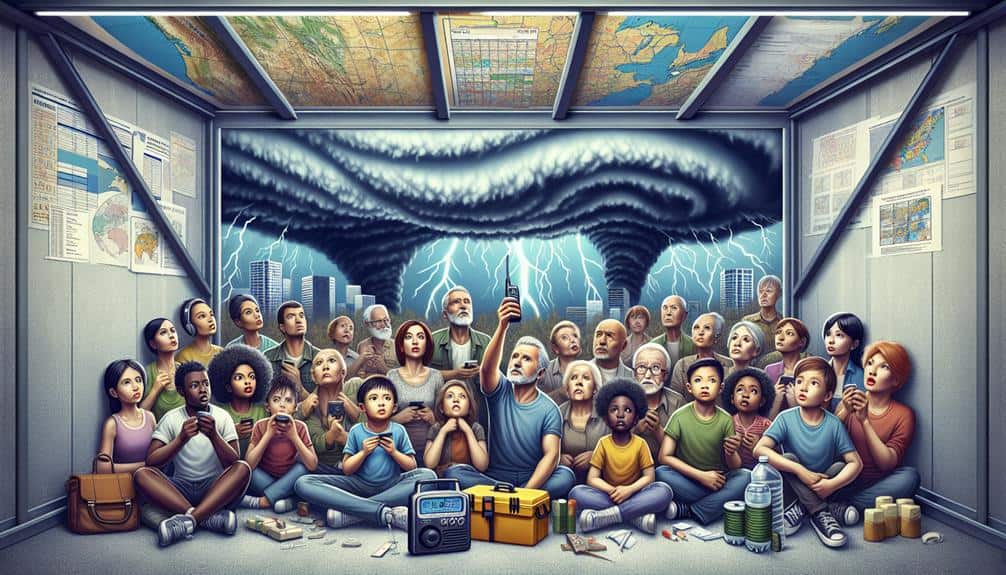Securing our safety during nighttime storm chasing demands careful planning and advanced technology. We must analyze meteorological data, track storm movements, and review radar and satellite outputs. Using bright headlamps of 300 lumens and reliable radios with extended battery life enhances visibility and communication. We should wear reflective gear for 500-feet visibility and plan multiple evacuation routes. Monitoring real-time weather updates and subscribing to emergency alerts helps us anticipate atmospheric changes. Carrying satellite phones and GPS devices guarantees precise location data. If we incorporate these measures, we can greatly diminish risks during our storm chasing adventures.
Key Points
- Wear reflective gear to boost visibility and ensure safety during nighttime storm chasing.
- Use bright headlamps with at least 300 lumens and carry spare batteries for continuous illumination.
- Monitor real-time weather updates through reliable radar apps and emergency alert systems.
- Ensure reliable communication with water-resistant, shockproof radios, and fully charged satellite phones.
Check Weather Forecasts
Before commencing a nighttime storm chase, we'll thoroughly analyze meteorological data and reliable weather forecasts. This initial step is crucial for identifying potential storm development zones, tracking storm movements, and determining intensity. We'll review radar imagery, satellite data, and model outputs to pinpoint areas of concern. By integrating data from National Weather Service (NWS) advisories and Severe Storm Prediction Center (SPC) outlooks, we can accurately forecast storm paths and potential hazards.
Our analysis isn't just about the storm; it includes identifying emergency shelters and planning evacuation routes. We need to know where the nearest shelters are in case conditions deteriorate beyond safe chasing limits. Emergency shelters provide a secure refuge against extreme weather elements, safeguarding our safety when immediate action is necessary.
Mapping out evacuation routes is equally essential. We'll chart multiple egress paths from our chase location to avoid being trapped by unforeseen changes in storm behavior or blocked roads.
Meteorological precision combined with safety planning guarantees that our desire for freedom and exploration doesn't compromise our well-being. By prioritizing data and preparedness, we'll be prepared to navigate the complexities of nighttime storm chasing with confidence and responsibility.
Equip Proper Lighting
Proper lighting equipment is crucial for enhancing visibility and maximizing safety during nighttime storm chasing operations. We need to prioritize the use of bright headlamps to maintain clear visibility in low-light conditions. Headlamps with a lumen rating of at least 300 lumens are ideal, providing sufficient illumination to navigate safely and observe storm patterns. Adjustable beam angles allow us to focus light where it's most needed, enhancing our operational efficiency.
In addition to headlamps, flashing beacons are essential for safety. These devices, often mounted on vehicles, emit high-intensity, intermittent light signals that increase our visibility to others, reducing the risk of collisions in low-visibility environments. Flashing beacons with multiple modes, including strobe and steady light, can adapt to different situational requirements, ensuring peak performance.
We must also consider the battery life of our lighting equipment. Lithium-ion batteries are preferred due to their long-lasting power and reliability in extreme weather conditions. Carrying spare batteries and chargers guarantees that our lighting remains functional throughout the chase.
Use Reliable Communication Tools
We must prioritize robust communication tools to guarantee safety and efficiency during nighttime storm chasing. Implementing high-frequency radio systems, utilizing satellite phones for unbroken connectivity, and employing GPS tracking devices for precise location data are essential. Effective communication reduces risks and enhances coordination, based on empirical evidence and field data.
Choose Robust Radio Systems
Selecting sturdy radio systems guarantees reliable communication during nighttime storm chasing, improving safety and coordination. Our ability to convey real-time information depends on the use of tough equipment designed to withstand severe weather conditions. Enhanced communication is essential when maneuvering through the unpredictable nature of storms after dark.
To maintain peak performance, we should focus on the following aspects of radio systems:
- Frequency Range: Choose radios with a wide frequency range to cover various emergency channels and ensure consistent connectivity.
- Battery Life: Opt for models with prolonged battery life or interchangeable battery options to sustain communication throughout extended chases.
- Durability: Invest in radios that are water-resistant and shockproof to withstand harsh environmental conditions.
Enhanced communication isn't just a convenience; it's a necessity. Sturdy equipment ensures that our radios function reliably, regardless of the storm's intensity. By carefully selecting robust radio systems, we not only safeguard our safety but also maintain seamless coordination with team members and emergency services.
Let's remember, in the pursuit of freedom and adventure, our preparedness is our greatest ally.
Utilize Satellite Phones Effectively
Effective use of satellite phones ensures uninterrupted communication when conventional networks fail during nighttime storm chasing. When we're out in the field, maintaining connectivity is vital for both safety and strategy. Satellite phones operate independently of terrestrial infrastructure, making them reliable during severe weather conditions.
By setting up a structured communication plan, we can avoid isolation. This involves regular check-ins with our team and designated emergency contacts. We should program these contacts into our satellite phones for quick access. Predefined intervals for communication help us maintain situational awareness and guarantee everyone remains informed.
We also need to be mindful of satellite phone battery life. Carrying fully charged spare batteries or portable chargers is essential. Regularly testing our satellite phones before heading out can prevent unexpected failures. Additionally, understanding how to operate the phone's GPS functionality can further enhance our ability to relay precise locations in case of emergency.
Using satellite phones effectively is about more than just having the device—it's about integrating it into our overall safety protocol. By doing so, we maximize our freedom to chase storms confidently, knowing we've minimized potential risks and upheld critical lines of communication.
Employ GPS Tracking Devices
Using GPS tracking devices guarantees precise real-time location data, which is vital for coordinating movements and enhancing safety during nighttime storm chasing. These devices utilize satellite signals to provide accurate tracking precision, which is essential when navigating through unpredictable weather patterns in the dark.
When we're out storm chasing, maintaining awareness of our exact location is non-negotiable. GPS tracking devices equip us with the tools to achieve this, but we must consider several factors to maximize their effectiveness:
- Battery life: Make sure our devices are fully charged and carry backup batteries or power banks. A dead GPS device can leave us vulnerable.
- Tracking accuracy: Opt for high-quality devices known for their reliability and precision. Inaccurate data can lead to risky miscalculations.
- Durability: Select GPS devices that can withstand harsh weather conditions. Storm chasing often involves exposure to intense elements.
Wear Reflective Gear
Wearing reflective gear is crucial for enhancing visibility and safety during nighttime storm chasing. When we're out in the field, it's not just about capturing the perfect shot; staying visible can be a matter of life and death.
We should choose bright, fluorescent colors for our gear. These colors increase our visibility to passing vehicles and fellow chasers. Reflective strips on jackets, pants, and hats reflect light from headlights, ensuring we're seen from a distance.
Data from the National Highway Traffic Safety Administration (NHTSA) indicates that pedestrian visibility is notably improved by wearing high-visibility clothing. Reflective materials can boost visibility by up to 500 feet in low-light conditions. This means drivers have more time to react, reducing the likelihood of accidents.
Let's not forget the importance of reflective vests. These vests can be worn over any clothing, ensuring that even if we're dressing for warmth, we don't compromise visibility.
By incorporating reflective gear into our storm chasing toolkit, we're taking a proactive approach to safety. It's about balancing the thrill of the chase with the responsibility of staying safe.
Monitor Changing Conditions

We must continuously monitor changing conditions by accessing real-time weather updates through reliable radar apps.
Utilizing advanced radar technology allows us to track storm movements with high accuracy.
Additionally, subscribing to emergency alert systems guarantees we receive critical notifications promptly.
Real-time Weather Updates
Staying updated with real-time weather data is vital for anticipating sudden atmospheric changes and ensuring safety during nighttime storm chasing. By leveraging accurate storm tracking and timely weather updates, we can make informed decisions and avoid hazardous conditions.
Modern technology enables us to access a wealth of meteorological data instantly, providing important insights into storm development, movement, and intensity.
We should consistently monitor:
- Weather satellites: These provide detailed imagery and data on cloud cover, temperature, and moisture levels.
- Severe weather alerts: Real-time warnings from meteorological agencies about tornadoes, thunderstorms, and other severe weather phenomena.
- Storm chasers' networks: Collaborations with other storm chasers provide firsthand observations and updates from the field.
Using these tools, we can enhance our situational awareness and maintain a strategic advantage. This data-driven approach minimizes risks and maximizes our ability to chase storms safely.
It's essential that we stay agile and ready to adapt our plans based on the latest information. By doing so, we embrace the freedom of storm chasing while ensuring we prioritize safety and preparedness.
Radar App Utilization
Harnessing radar applications enables us to monitor rapidly changing conditions in real-time, enhancing our ability to make immediate and well-informed decisions during nighttime storm chasing. These apps offer high-definition radar imagery, storm tracking data, and accurate weather overlays, which are crucial for evaluating storm movement and intensity. By utilizing these tools, we can pinpoint the location of severe weather cells and track their progression with exceptional precision.
Our safety measures are greatly strengthened by the use of radar apps. Real-time data allows us to steer clear of hazardous areas, optimizing our chase routes to maintain a secure distance from potentially life-threatening conditions. We can also identify crucial features such as hook echoes, which signal potential tornado formation, and adjust our positioning accordingly.
Moreover, radar apps often include lightning detection, wind speed indicators, and precipitation estimates. These components contribute to a thorough situational awareness, enabling us to make prompt, data-driven decisions. Being equipped with such precise technology guarantees that we maximize our flexibility to chase storms while minimizing risks.
Integrating radar app utilization into our nighttime storm chasing strategy isn't just beneficial; it's essential for ensuring safety and achieving successful storm tracking outcomes.
Emergency Alert Systems
During nighttime storm chasing, integrating emergency alert systems allows us to monitor changing conditions with unmatched accuracy and immediacy. These systems provide real-time alert notifications, enabling us to make informed decisions and take swift emergency response actions.
Harnessing advanced technology, we can access critical weather updates and warnings, ensuring our safety and enhancing situational awareness.
To maximize the effectiveness of emergency alert systems, we should consider the following key features:
- Geotargeted Alerts: Receive notifications tailored to our specific location, ensuring relevance and timeliness.
- Multi-Channel Notifications: Utilize multiple communication channels (e.g., SMS, email, app alerts) to guarantee we receive critical updates regardless of connectivity issues.
- Customizable Alert Settings: Adjust alert thresholds based on our risk tolerance and specific storm-chasing scenarios.
Plan Escape Routes
Mapping out multiple escape routes is essential for guaranteeing swift and safe evacuation during unexpected changes in storm patterns. We must prioritize emergency planning by identifying all viable egress routes in advance. Given the dynamic nature of storm systems, having pre-determined paths can greatly reduce reaction time and enhance our overall safety measures.
Using topographic maps and real-time GPS data, we can chart at least three alternate routes per location. These routes should account for variables such as road closures, traffic congestion, and potential obstructions. Leveraging meteorological data, we can predict storm movement patterns and adjust our escape routes accordingly. Our planning should include high-resolution weather radar and satellite imagery to guarantee the most accurate information is guiding our decisions.
We should also conduct regular drills to familiarize ourselves with these routes under various conditions, thereby minimizing hesitation in a real emergency. Utilizing mobile applications that offer real-time traffic updates and hazard alerts can further refine our escape strategy.
Avoid Flood-Prone Areas

In conjunction with planning escape routes, we must rigorously identify and avoid flood-prone areas to mitigate the risk of getting trapped by rising waters during our nighttime storm chasing activities. Flooding not only hampers our ability to navigate but also exponentially increases the risk to our safety. To guarantee we remain agile and responsive, we need to utilize topographic maps and floodplain data meticulously.
By leveraging real-time weather data and predictive modeling, we can pinpoint areas most susceptible to flash flooding. It's crucial to cross-reference this data with our planned evacuation routes and identify potential emergency shelters.
Key actions include:
- Utilize GIS tools: Geographic Information System (GIS) tools enable us to visualize flood-prone zones accurately.
- Monitor real-time alerts: Subscribe to real-time flood alerts and weather updates to adapt our routes dynamically.
- Pre-plan shelter locations: Identify emergency shelters along our route to ensure we've safe havens if conditions deteriorate.
Frequently Asked Questions
What Should I Do if My Vehicle Breaks Down During a Nighttime Storm Chase?
If our vehicle breaks down during a nighttime storm chase, we should immediately execute our emergency plan. Prioritize safety measures, such as moving to a safe location, and continue storm filming from a secure distance if conditions permit.
How Can I Ensure My Safety When Filming During a Nighttime Storm?
Securing our safety while filming at night, we must wear safety gear and establish a robust communication plan. Equip ourselves with reflective vests and helmets, and maintain constant radio or mobile contact to uphold situational awareness.
Are There Specific Apps That Can Help Track Storms Effectively at Night?
We can enhance nighttime visibility and safety using advanced storm tracking technology. Apps like RadarScope and MyRadar offer precise real-time data. They utilize radar and satellite imagery, providing critical information to help us navigate safely during nighttime storms.
How Can I Prepare Mentally for the Challenges of Nighttime Storm Chasing?
We can enhance our mental preparation by studying meteorological data, understanding potential challenges, and practicing nighttime safety protocols. Taking these precautions guarantees we're ready to face unpredictable conditions while maintaining our sense of freedom and adventure.
What Are the Best Practices for Storm Chasing With a Team at Night?
We guarantee team communication, follow strict safety protocols, verify equipment readiness, and establish a clear emergency plan. This approach maximizes safety, minimizes risk, and enhances our ability to enjoy the freedom of nighttime storm chasing.


